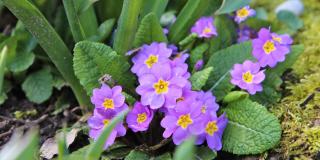

Primrose is one of the first flowers to bloom in the year.
Prime Primrose facts
Name – Primula
Family – Primulaceae
Type – perennial
Height – 4 to 20 inches (10 to 50 cm) depending on the variety
Exposure – full sun, part sun, shade
Soil – rather rich, well drained and cool
Blooming – October to April or February to September
A must-have in the garden, caring for it is easy and requires little attention, whereas its blooming will enchant you.

You can also add organic soil conditioner such as manure and seaweed.
From seed, sow primrose starting from the month of May for it to have settled in by fall.
If going along this path, sow in a tray and transplant 1 month later, still simply in a larger tray. Yet another month later, transplant to a nursery pot. Finally, transfer to the ground starting in October.
Remove wilted flowers as they die off to boost bearing of new flowers.
Your primroses can be propagated through crown division after the blooming.
In the event of a slug invasion, make the most of the ashes from your fireplace to fight them off.
Primroses are perennials that are particularly appreciated for their fall, winter and spring blooming and the bright colors of their flowers.

Sometimes they’ll need to be set outside overnight to let them rest a bit in cool air.
In flower beds, along edges, in rock gardens or in garden boxes, primroses are very easy plants to maintain and are very ornamental when most other deciduous plants have lost their cover…
Why not try to sprinkle your mixed salads with flowers and also toss in a few young primrose leaves, they’re perfectly edible!
Having added soil conditioner upon planting will enhance the plant’s growth and blooming.